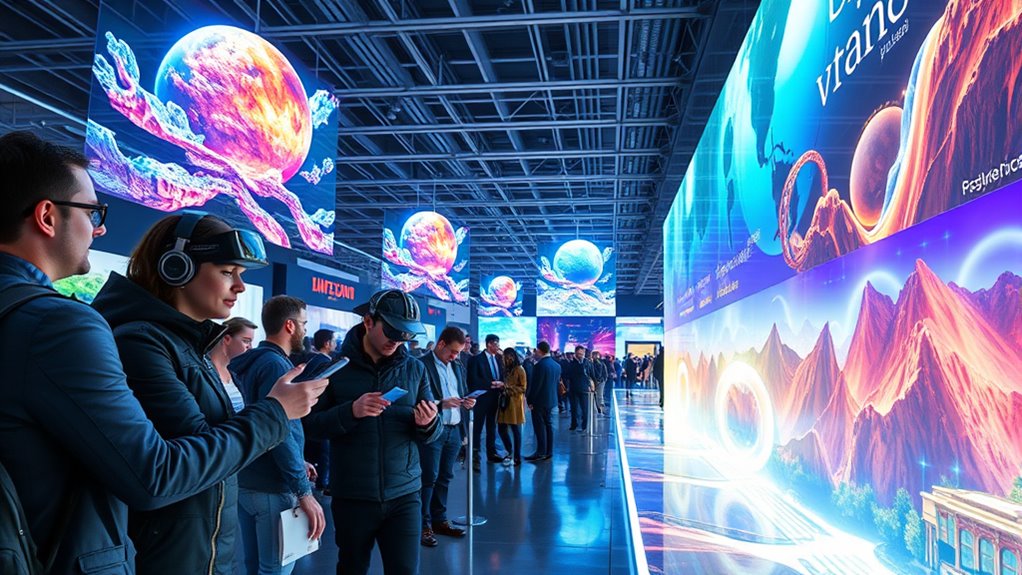Big Tech companies like Meta, Google, Microsoft, and Apple are racing to lead the metaverse by 2025. They’re investing billions in creating immersive digital worlds and seamless AR experiences that will reshape your work, social life, and entertainment. While some focus on transparency and privacy, others rush to deploy new tech, raising concerns about data safety. If you want to understand how these ambitions could impact you and what’s at stake, keep exploring further.
Key Takeaways
- Major tech giants are investing billions to develop immersive, seamless AR-enabled metaverse experiences aimed for mainstream adoption by 2025.
- Leading companies focus on blending physical and digital worlds, with AR devices enhancing real-life interactions and social engagement.
- Industry leaders emphasize privacy safeguards, but inconsistent privacy protections pose challenges to user trust and safety.
- Competition centers on technological innovation, AR integration, and establishing dominant digital environments in the evolving metaverse.
- The race for metaverse dominance hinges on companies’ ability to balance immersive experiences with robust privacy and data security measures.

Have Big Tech companies truly set their sights on transforming the metaverse by 2025? It certainly seems that way, as industry giants pour billions into developing immersive digital worlds. Central to this push is AR integration, which promises to blend our physical environments with digital overlays seamlessly. Imagine walking down the street and seeing virtual advertisements, interactive guides, or social avatars right beside you, all thanks to advanced augmented reality. This technology aims to make the metaverse feel more real and accessible by merging it with everyday life. However, as companies accelerate their efforts, privacy concerns quickly come into focus. With AR devices constantly collecting data—like your location, movements, and even facial expressions—the risk of personal information being misused or hacked increases profoundly. You might find yourself wondering how much of your life is being tracked and whether your privacy will be protected as these technologies become mainstream.
The drive toward AR integration isn’t just about creating cool features; it’s about making the metaverse a natural extension of your real-world experiences. Companies want you to wear AR glasses or contact lenses that enhance your surroundings without interrupting your day. This level of integration could revolutionize how you work, socialize, and entertain yourself. But it also raises the stakes for privacy. Unlike traditional online platforms, AR experiences can be deeply personal because they interact with your physical environment and bodily movements. If data collection isn’t carefully managed, it could lead to invasive profiling or unauthorized surveillance. You might worry about who has access to your data, how it’s stored, and whether there are safeguards against breaches. These concerns are not just hypothetical; many users feel uneasy about the potential for their private moments to be exposed or exploited.
Big Tech is aware of these privacy issues and is making efforts to address them, but progress is uneven. Some companies promote transparency and security protocols, emphasizing user control over data. Others, however, may prioritize rapid deployment over privacy safeguards, risking public trust. As a user, you’ll need to stay informed about how your information is being used and advocate for stronger privacy protections. The challenge for these companies is to balance innovative AR integration with ethical data handling—something that’s vital if the metaverse is to become a safe, widely accepted space. As this technology advances, the importance of establishing robust privacy safeguards cannot be overstated. Ultimately, if they succeed, you’ll enjoy a more immersive, personalized digital experience. But if privacy concerns aren’t adequately managed, widespread adoption could stall, and trust in the metaverse could erode just as quickly as it’s being built.
Frequently Asked Questions
How Will Privacy Be Protected in the Metaverse?
You’ll see privacy protected through strict privacy regulations and clear user consent policies in the metaverse. Companies are expected to implement advanced security measures, ensuring your data stays safe and your rights are respected. By actively managing your privacy settings and being aware of data collection practices, you can control your personal information. In this evolving space, prioritizing transparency and user consent will be key to safeguarding your privacy effectively.
What Are the Environmental Impacts of Metaverse Infrastructure?
Imagine your virtual world as a lush forest—its health depends on sustainable energy. The metaverse infrastructure’s environmental impact hinges on its carbon footprint, which can be significant if powered by non-renewable sources. You can help reduce this by supporting platforms investing in green energy. As the metaverse grows, its environmental footprint will shrink if creators prioritize eco-friendly infrastructure, making your virtual experiences more sustainable and less damaging to the planet.
How Will Digital Ownership Rights Be Secured?
You can guarantee digital ownership rights by using blockchain technology to establish transparent digital contracts for virtual property. These contracts ensure that your rights are recorded immutably, preventing unauthorized transfers or disputes. Smart contracts automate enforcement, giving you confidence that your virtual property is protected and owned solely by you. This system creates a reliable, tamper-proof record, making digital ownership secure and verifiable in the evolving metaverse.
What Accessibility Measures Are Planned for Diverse Users?
In this brave new world, you’ll find that inclusive design and adaptive interfaces are at the forefront of accessibility plans. Big tech companies aim to guarantee diverse users can navigate the metaverse effortlessly, offering customizable options for visual, auditory, and mobility needs. These measures make virtual spaces more welcoming, allowing everyone to participate fully. It’s like having a personal assistant from the Victorian era guiding you through the digital sphere.
How Will Interoperability Between Different Metaverse Platforms Work?
You’ll see interoperability between metaverse platforms improve through the adoption of cross-platform standards and data interoperability protocols. These standards allow different virtual environments to communicate seamlessly, enabling you to move assets, avatars, and data across platforms without issues. As major companies collaborate on these standards, your experience becomes more unified, giving you the freedom to explore various virtual worlds effortlessly and ensuring your digital belongings stay connected across the metaverse ecosystem.
Conclusion
By 2025, you’ll see big tech giants jockeying for dominance in the metaverse, like players in a high-stakes game. Their ambitions are shaping a digital world as vibrant and complex as a bustling city street. Whether you’re exploring new virtual landscapes or just watching from the sidelines, one thing’s clear: the race is only heating up, and the future of the metaverse will be as dynamic and unpredictable as a rollercoaster ride.









